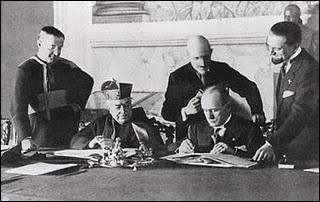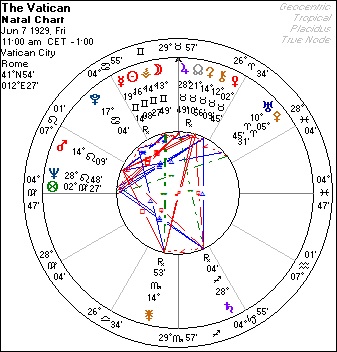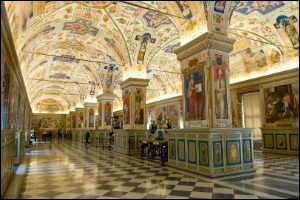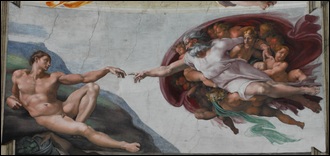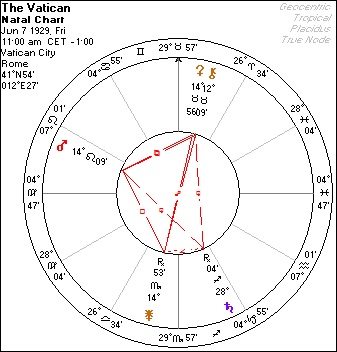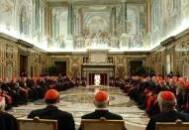advertisements
NeptuneCafe presents
Introduction
The Astrology of the Vatican and
Predator Priests
The Catholic Church's reputation seems to have peaked when Pope John Paul II was running the Vatican. His enormous popularity around the globe was well deserved for his good works, which included
improving the Church's relations with Jews and Muslims. The Polish Pope supported debt relief in third world countries, campaigned against the Iraq War, and established World Youth Day. He asked forgiveness for the Church's historical errors and its poor treatment of women and indigenous peoples. Mikhail Gorbachev credited him with facilitating the fall of Communism across Europe and the Soviet Union.
Over the last few years, which has loosely corresponded to the reign of Pope Benedict XVI, the main stories we hear about the Church are about sex crimes committed by Catholic priests. Of course, these crimes have been going on for many years, with documented pedophile cases over a century old. But for the most part, these
stories didn't make the front page news. Predator priests were told to repent and were then transferred to different regions while their crimes were quietly dismissed. Pope John Paul II was aware of this growing epidemic, but he supported handling the problem within the Catholic Church rather than warning the local community or reporting sex abuse crimes to the local authorities.
An astrological picture of the Catholic Church begins with the horoscope of the Vatican, which was granted independence by Benito Mussolini on June 7, 1929 (11:00 am; Vatican City, Rome). This event (including the time) was reported on the front page of the New York Times the following day, and a chart set for this moment works well. Earlier charts for the Catholic Church could be set for the beginning of St. Peter's papacy (the first pope) around 39 AD, as well as various dates afterwards when the Roman and other world empires granted the pope authority and land. But the precise dates for these events are uncertain, while we do have a widely accepted and effective chart for the Catholic Church's modern incarnation.
The date and time for the Vatican is for the signing of the Lateran Treaty which brought the city-state into existence. The treaty speaks of the Vatican City as a new creation, and not a vestige of the once powerful Papal States, most of which was absorbed into the Kingdom of Italy by 1860. The Vatican City has an elected monarch, known as the Bishop of Rome, and who is also the Pope of the world's entire Catholic population. The Treaty was signed by Cardinal Pietro Gaspari on behalf of Pope Pius X1 and Benito Mussolini, the Prime Minister of Italy.
Like the dwarf planet Pluto, the Vatican's influence extends far beyond what its appearance might indicate. Currently, the world has 1.2 billion Catholics and each of them nominally believe that the Pope, who resides in Vatican City, is their infallible spiritual leader. As such, the Vatican's horoscope becomes one of the most important charts to understand as we head into the Age of Aquarius.
The Vatican's Jupiter
Jupiter, the planet traditionally associated with religion, is the most elevated planet in the Vatican's horoscope. It's only one degree from the Midheaven, and in Taurus, describes the rock solid principles of the Catholic Church which have been tested and protected for over a thousand years. Jupiter in Taurus may also relate to the vast fortune that is contained within the Vatican City in the form of treasured artifacts, as well as the vast financial holdings in various institutions around the world. Numerous books have been written about the Vatican's wealth, much of which is hidden from prying eyes by sovereign immunity.
Venus is also in Taurus and trine to the Virgo Ascendant, which further supports the notion (if not the fact) of a vast financial empire. Venus is directly associated with art, and we know that within Vatican City are some of the greatest museums in the world containing the fabulous, priceless masterpieces collected by the Catholic Church over the centuries. Venus is in the ninth house of religion, and all the classic architecture, frescoes, and paintings are classified as religious art. Some of the best known are from the Renaissance period, and include works by Leonardo da Vinci, Caravaggio, Michelangelo, and Raphael.
Jupiter gains influence in the Vatican's horoscope by being conjunct the Midheaven and the Pleiades, as well as its close aspects to Neptune and Saturn, which modify its meaning. The square to Neptune is the closest aspect in this chart (orb: 0º01'), and defines the overall religious tradition as being associated with a spiritual monarch. Neptune is in the regal sign of Leo and conjunct Regulus, the first magnitude star often associated with royalty.
Jupiter is also quincunx (150º) to Saturn at 28º Sagittarius. Most anyone born with Saturn in Sagittarius is on a karmic path to learn about religious authority, and here, Saturn aspecting Jupiter and Neptune emphasizes this theme. Saturn, in turn, trines Neptune, so that the Vatican horoscope is dominated by this three-planet configuration involving Jupiter, Neptune and Saturn. Jupiter, perhaps representing the all-powerful Pope, is influenced by spiritual concerns (Neptune) and practical matters (Saturn).
As a technical note, the tools used here to correlate actual events with the natal horoscope include the outer planet transits as well as secondary progressions. Most astrologers use the transiting outer planets, but not enough use the progressions, perhaps because the broader audience has no idea what they are. To summarize, progressions are based on the esoteric formula that one day after birth is symbolically equivalent to one year after birth. The progressions represent unique internal developments
which are often manifested externally, while the transits are the same for everyone, but become important to the individual when they align with natal placements. In this article, the progressed Sun and Mars are most relevant, because we're discussing an evolving patriarchy. The progressed Sun moves one degree per year, while progressed Mars generally moves at two degrees every three years. The progressed Moon is also relevant for pinpointing timing, since it advances at the rate of one degree per month.
An example of how Saturn and Neptune weighed on Jupiter can be seen in the first elected Pope of the modern era. Pope Pius XI died on February 10, 1939 at a time when Hitler was on the rise and Europe was becoming a very dangerous place. Historians have characterized the conclave's decision at the time as being a
choice between a diplomatic or spiritual candidate. On March 2, 1939, the conclave elected Eugenio Pacelli, who was Pius XI's Cardinal Secretary of State. Pacelli had earned the reputation for being a shrewd diplomat, including the arrangement of four agreements with Germany which protected Catholics within the Nazi homeland. Pacelli took the name of his predecessor, calling himself Pope Pius XII.
Looking at the astrological factors during Pope Pius XII's election shows how practical Saturn was the reigning archetypal force. First, the progressed Moon during the month of February was in late Libra, where it was sextile Neptune on one side and sextile Saturn on the other. Here we see the conclave's dilemma, with the indecisive Libra torn between a spiritual (Neptune) and practical (Saturn) candidate. However, Libra is the sign of the diplomat, and Saturn by transit was sextile the Vatican Sun. Also, the Vatican's progressed Sun was approaching an opposition to natal Saturn. The conclave made their pragmatic, realistic, tough-minded decision when the progressed Moon was precisely quincunx the Midheaven. Transiting Neptune was making no aspects at this time, nor were any planets by transit or progressions activating natal Neptune.
Planets conjunct or closely aspecting the angles (the Midheaven, Ascendant and their polar opposites) are generally the most prominent planets in the chart. In the Vatican's case, we have Jupiter conjunct the Midheaven and Venus trine the Ascendant. The greater and lesser benefic define this entity's religious wealth in a form of mutual reception: Jupiter is in Venus's sign and Venus is in Jupiter's house. To say that the Vatican is wealthy is surely an understatement. Some researchers claim the Pope is the wealthiest man on the planet, while the Vatican Bank has been the source of much investigation and scandal over the past few decades. But that's another story....
The Midheaven itself is located at 29º Taurus, which happens to correspond to the star group known as the Pleiades. The seven visible stars in this cluster have guaranteed it a special place in many ancient and modern cultures. The name we use, the Pleiades, comes from the Greek culture and refers to the Seven Sisters, each of which had some fateful role in Greek mythology. Traditional Western astrologers have associated the Pleiades with blindness, sorrow, and judgment of the dead. Bernadette Brady offers this advice when considering the Pleiades in chart interpretation:
"There will be a sense of vision or insight via the planet with which it is involved, with a caution against making rash judgments or being narrow-minded to the point of becoming blind to the obvious. You have the potential for real insight and understanding, so it is important that you do not use this to make harsh judgments."
The Vatican Mars
The Catholic Church has long been a bastion of male supremacy, a patriarchal institution which absolutely forbids the ordination of women as priests. As such, the condition of the Vatican Mars – the archetypal symbol of masculinity – is of great interest, especially considering the eruption of sexual scandals over the past decade.
Mars is in proud Leo, a placement that offers a lust for life, full of vitality and self-confidence. In general, Mars in Leo loves sex and may be considered a magnificent lover. However, in the Vatican horoscope, Mars is restrained from this activity by Catholic doctrine, which can be seen astrologically by the close trioctile (or sesquiquadrate aspect, 135º) to Saturn in moralistic Sagittarius.
Most significantly, Mars is located in the 12th house, the house of secret activities, isolation, and what traditionally has been called the "house of self-undoing". Many astrologers associate Mars in the 12th house with spiritual activity, since Mars is the energy planet and the 12th house is our connection to spirit guides and the collective unconscious. In this sense, we can see Mars as a symbol of the monkish self-denial that many Catholic priests exhibit so that they may engage in their prayers and behind-the-scenes activities that further the Catholic Church's mission.
But Mars in the 12th house making a challenging aspect to Saturn is a clear signature for repressed sexuality. Mars is charged up by a trine to Uranus and sextile to the Sun and Moon in Gemini, and no papal decree can bottle this energy up. The celibate priest must find suitable outlets for this sexually-charged energy, and without a wife or partner, unsanctioned substitutes had to be found. The Vatican's 12th house Mars, we know now, is a symbol for hidden sexual activities of the most depraved kind: Catholic priests across the globe have been sexually abusing vulnerable boys.
Using the traditional planets, Mars in the 12th house has only one challenging aspect, the trioctile from Saturn. Otherwise, Mars seems well-placed. The favorable aspects to the Sun, Moon and Uranus indicate that most priests could dutifully live with the celibacy rules and still have a fulfilling life by acting out their religious beliefs.
Yet when we add the asteroids in, the overall view of Mars shifts. Mars squares Ceres in Taurus on one side and Juno in Scorpio on the other. All three of these placements are at 14º of their respective signs, making a very tight T-square configuration. As such, Mars gains in importance, even as it's placed under additional pressure from these two feminine archetypes.
Ceres in Taurus is a great caregiver, as best represented by the parent who nurtures his child with proven traditional values. Mars square Ceres can be seen as the priest who supports individuals in his flock as if he were a parent, or a "father". Considering this modifying influence over the Vatican's 12th house Mars, we can see how some priests abused their role as caregiver and manipulated trusting young boys into shameful sexual acts.
Juno is the marriage asteroid, and in Scorpio, needs to feel that the relationship is balanced and fair. Otherwise, this Juno placement can become terribly vengeful. Juno in Scorpio also elevates the importance of sexuality in the relationship. The Mars-Juno square describes the tension between marriage and celibacy, and the ongoing debate over whether priests should be allowed to marry. And Juno's vengeance has emerged with the myriad lawsuits against the Catholic Church, the predator priests, and the cardinals who protect them.
To be sure, most Catholic priests have not become predators. Still, the staggering litany of sexual abuse cases has resulted in the Catholic hierarchy paying over $2 billion to compensate victims in the U.S. alone. Since the cases first achieved national attention in 2002, secondary waves of abuse claims and settlements have risen in Ireland, Italy, Belgium, Australia, Canada, New Zealand, Argentina, Germany, and other countries. And the story is not over by a long shot....
Part Two - The history of predator priests in the Catholic Church, and how Pope John Paul II and Pope Benedict XVII have dealt with it.
Part One of the article by Michael O'Reilly, excerpted from the October 2011 issue of Dell Horoscope. On this page: the Vatican horoscope and descriptions of its elevated Jupiter and 12th house Mars.
Part Two tracks the predator priest problem historically, and what John Paul II and Benedicit XVI have done about it.

